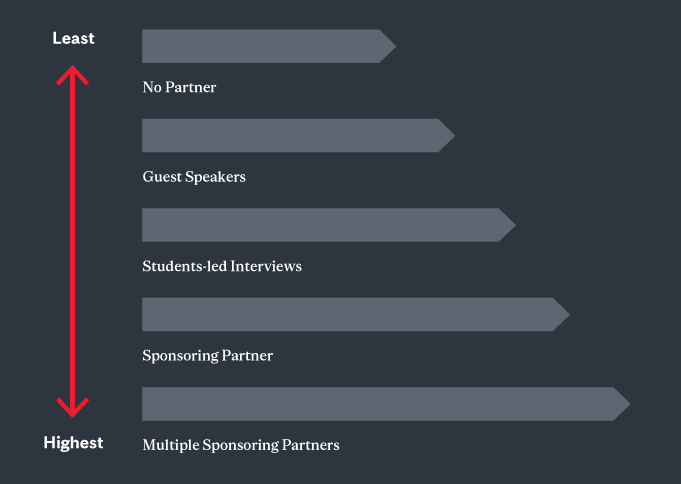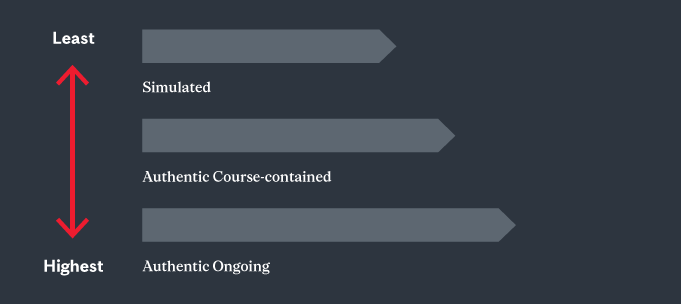Experiential Learning (EL) can be incorporated in your class along a continuum. This section offers a number of examples of EL activities that you can use to draw inspiration from.
Although it may seem that an EL activity must be lengthy, involve outside partners, or be in some way incredibly time-consuming to set up, that’s not the case! Experiential Learning can be implemented in a range of ways. The important points to remember are that it is intentional, hand’s on, up-to-date, reflective, and offers opportunities for feedback and assessment.
Time Commitment
Think about how much time you want to dedicate to the EL component. The more involved the project, the more time will need to be dedicated to it. This may mean removing other content or modifying other assessments.

- One to Two Classes: The activity is self-contained within one or two class sessions.
- Several Classes: The activity extends over several classes. Some class sessions may be dedicated to the EL activity, and students may have work to complete outside of class time to complete the activity.
- Several Weeks: The activity is fairly involved and extends over several weeks. Some in-class time may be dedicated to the activity, while students will be expected to do a fair amount outside of class hours.
- Entire Semester: The entire course is set up around an EL activity, and therefore both in and out of class time will be dedicated to the activity
Industry or Community Partners
You may opt to work with outside industry or community partners. This is a great way for students to learn more about different organizations and to network. It also allows for a more authentic and richer EL activity, as students will be able to hear from people on the ground in the industry. However, it can mean additional work setting up and running the EL activity. Keep this in mind when planning your EL activity.

- No Partner: The activity is completed without an industry or community partner. Students may use all publically available data or information, may participate in a field observation, or a simulation.
- Guest Speakers: Guests from the industry speak to all students together about topics directly related to their EL activity. The expectation is that these are one-off visits, and not a sustained relationship over the course of the activity.
- Students-led Interviews: Students, individually or in groups, reach out to people from the industry they are studying to conduct interviews. Partner involvement is limited to contact with the specific students, and is limited in scope.
- Sponsoring Partner: Instructor identifies one partner who will supply class with a problem or project. The relationship is more sustained over the course of the activity, and the partner will likely be available to students for interviews, feedback, and/or to listen to some or all of the final presentations.
- Multiple Sponsoring partners: Instructor identifies multiple partners who will each provide class with a project. Students will have some ongoing relationship with the sponsoring partner of their project, who may be available for interviews and/or final presentations, and may provide data or feedback throughout the activity.
Authenticity
The value of EL is in allowing students the opportunity to work directly on a problem or project (hands’-on) and to reflect on that experience. The type of problem or project students work on should be real-world; in other words, students are doing the types of activities they may do in the work force. How you bring that into the class can vary along the continuum below.

Simulated: Activity allows students to get a taste of the type of work they may do post-grad in a simulated environment. They type of work students are doing is authentic (meaning real-world and up to date), but the project itself is not from an actual business or organization. Examples might include:
- Case competitions
- Negotiations simulation
- Software-based simulation
- Processing a dataset
- Completing a tax form
Authentic Course-contained: The activity students work on is an actual problem or project from an industry or community partner. However, the project is designed to be completed within the context and timeframe of a course. Examples might include:
- Live cases
- Consulting project
- Market research
Authentic Ongoing: Students work on an activity that will have a lasting impact even after the course is over. Examples may include:
- Developing a working app
- Managing real funds
- Proposing a business strategy that will actually be implemented

